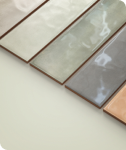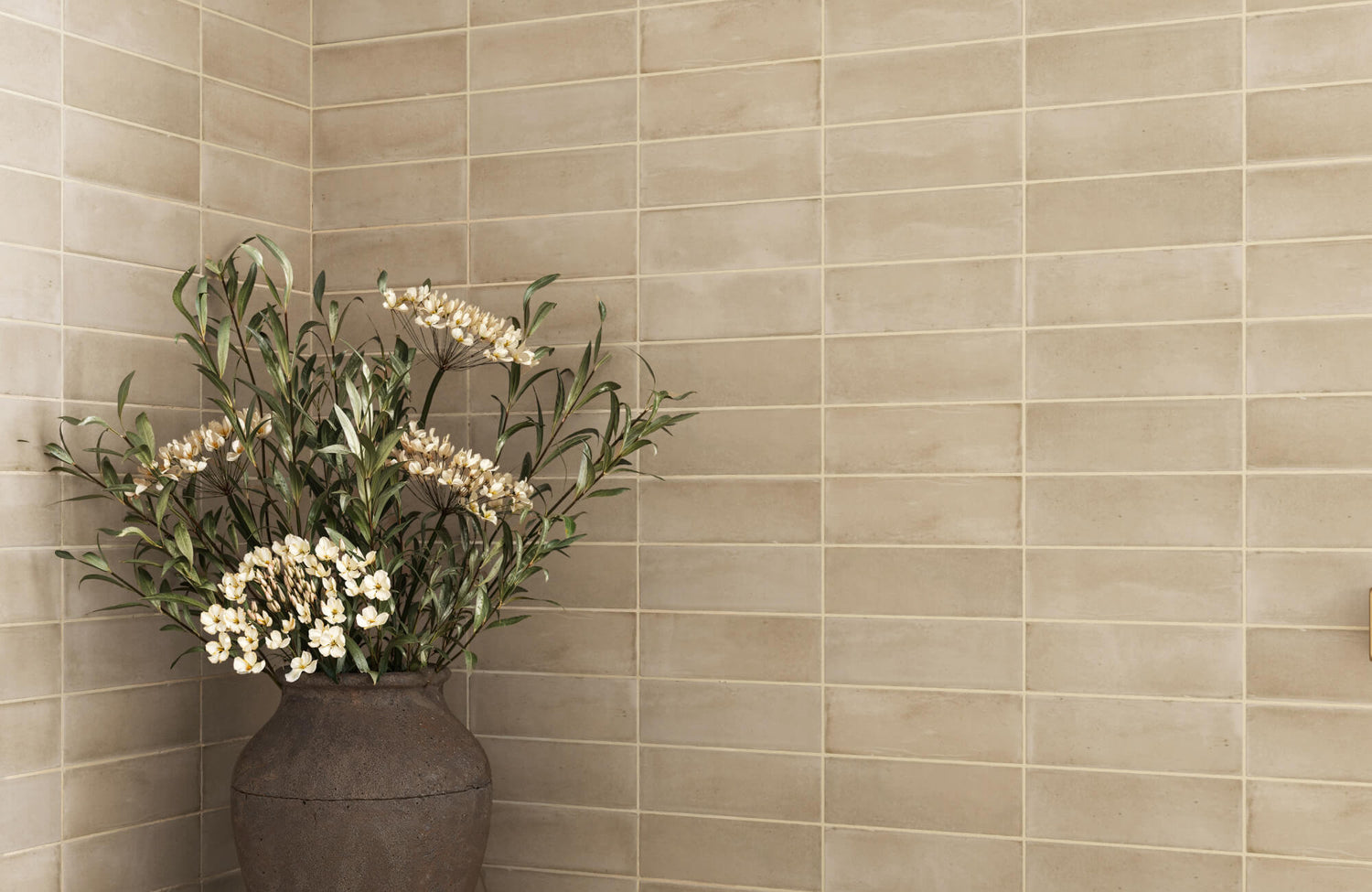Before diving into your next tiling project, especially with classic subway tiles, it’s important to know whether soaking them is necessary or just a leftover tradition. In this article, we break down everything you need to consider so you can make the right decision based on tile type, installation method, and performance expectations.

Understanding Why Soaking Tiles Were Common?
Soaking subway tiles used to be more than a suggestion; it was an essential step in traditional tile installations. To understand whether it’s still necessary today, we need to revisit how older tiles were made, the materials used in the past, and the limitations of installation techniques available at the time.
Clay-Based Tiles and Moisture Retention
Back when ceramic tiles were made primarily from natural clay and lacked the consistency of modern production methods, they were significantly more porous than what we see today. During installation, these tiles tended to absorb water quickly and often unevenly, which could disrupt the setting process. To manage that, soaking became a common and practical solution. Pre-saturating the tiles helped prevent them from drawing moisture too rapidly from the adhesive, which would otherwise compromise the bond.
By soaking the tiles ahead of time, installers could maintain better control over how the mortar or traditional setting bed cured, allowing it to dry at a steady, uniform rate for a stronger hold.
Importantly, this practice wasn’t about sealing or waterproofing the tile, it was about regulating how the tile interacted with moisture during the installation. Even today, if you’re working with clay-bodied or older-style ceramics in a restoration setting, soaking may still be a useful step to ensure stability and performance.
Old Mortar Systems and Water Loss
Before thinset became the norm, tiles were set into thick mortar beds; a method that required a slow and controlled drying process. These old systems depended on even moisture retention to cure properly and maintain strength over time. If a dry tile drew water away too quickly, it disrupted that balance and led to loose tiles or weak spots.
Soaking helped keep the hydration consistent across both tile and mortar, creating a uniform installation surface. This was particularly important in large-scale tilework or uneven substrates, where any change in curing time could throw off the entire section. Today’s thinset mortars are chemically formulated to perform differently, but understanding why soaking was once essential helps explain why it’s still recommended in specific scenarios.
Artisan vs Industrial Production
Tile production has come a long way. In the past, tiles were often handmade or produced in small batches with variable density and firing temperatures. That inconsistency translated into unpredictable water absorption. One batch of tiles might behave differently from another, and without soaking, you couldn’t guarantee the same setting conditions for each tile.
Soaking was a way to equalize this variability. By pre-wetting every tile, installers could work consistently, even if the tiles weren’t uniform. We still encounter this today when dealing with artisan or reclaimed subway tiles; beautiful options, but ones that sometimes benefit from a little traditional preparation.
This isn’t just nostalgia; it’s about understanding how materials have evolved and when the old ways still apply. If you’re considering handmade subway tiles, it’s worth checking whether soaking is part of the recommended prep process.

Identifying When Soaking Is Still Needed
Subway tiles have evolved, but soaking hasn’t disappeared entirely. In certain situations, soaking remains helpful; it’s still essential to achieve a secure and lasting installation. Let’s explore when taking this extra step truly makes sense.
Installations in High-Heat or Dry Areas
The surrounding environment also plays a big role in whether soaking is necessary. If you’re installing subway tiles in areas exposed to high heat or dry conditions, such as a sunlit backsplash, an outdoor patio wall, or an interior in an arid climate, moisture from the adhesive can evaporate too quickly.
In these cases, soaking tiles briefly before installation can create a buffer. It slows down water transfer and helps maintain a consistent bond. Even if the tile isn’t particularly porous, the dry air can work against your adhesive. Think of soaking as a smart adjustment to external conditions, not just tile type.
Poor Surface Contact
Not all tile backs are created equal. Some have uneven ridges, irregular textures, or non-flat surfaces, particularly in handmade or small-batch runs. These imperfections can create small gaps between tile and adhesive, which reduces grip and makes it more difficult to achieve a clean, flush installation.
In that case, a short soak can help improve the initial tack by slightly softening the tile surface and encouraging more complete contact with the adhesive. Although it’s not a cure-all, this step can also make a difference when paired with the right trowel technique.

Exploring the Risks of Soaking Modern Tiles
Although soaking has its role, it’s not always beneficial, and in the wrong scenario, it can do more harm than good. Most modern subway tiles are engineered for performance, and soaking can disrupt the features that make them so reliable.
Over-Saturation and Adhesive Failure
Most adhesives today are made for dry installations. They rely on a carefully balanced formula to create a strong, chemical bond. It can throw that balance off when tiles are soaked, especially if they have been submerged too long.
Excess water trapped in the tile can weaken the bond by preventing proper adhesion. In severe cases, tiles may slide, fail to stick, or even detach over time. This issue is common with non-porous tiles, particularly porcelain, which don’t need soaking. What’s intended as a preparation step can also turn into a performance problem.
Surface Cracking and Crazing
Glazed ceramic tiles are undeniably beautiful, but their delicate surface layer can become vulnerable when exposed to the wrong conditions. In particular, soaking can create internal stress if the glaze and the underlying tile body expand at different rates.
This mismatch often results in crazing, which appears as fine, hairline cracks in the glaze after installation. While typically cosmetic, crazing can still influence how well the tile withstands moisture over time and may impact its long-term appearance. That’s why, if you’re working with subway tiles that feature a glossy finish like our Palmer 3x12 Glossy Porcelain Tile in Mint, crackled, or specialty glaze, it’s best to avoid soaking unless the manufacturer explicitly recommends it.
Inconsistent Results with Factory-Made Tiles
Although modern tile lines are manufactured with high precision, their response to moisture isn’t always consistent. Depending on factors like finish, composition, or even subtle color variations, some tiles may absorb water more slowly, while others take it in more rapidly.
When soaking is applied inconsistently, whether by soaking some tiles and not others or by varying the soak time, you risk creating uneven results. This can lead to bonding issues, irregular drying patterns, or visible shading differences across your wall. It may also affect how evenly the tiles sit once installed. That’s why dry installation is generally the more dependable approach when working with factory-finished subway tiles.
How To Know If Your Subway Tile Needs Soaking
We never want to make installation decisions based on assumptions. Fortunately, you don’t have to guess. There are clear, simple ways to test your subway tiles before you open the thinset. Here’s how to evaluate your tile’s water absorption and decide if soaking belongs in your plan.
The Water Drop Test
Start with the back of the tile, the part that will bond to the wall. Place a single drop of water on the surface and wait a few seconds. If it disappears immediately, your tile is porous and may benefit from soaking, but if the drop beads up or sits for a while, soaking is unnecessary. This quick test can give insight into how your tile will interact with adhesive. It’s not a lab experiment, just a reliable visual cue that takes only seconds but can also prevent a major setback later.
Tile Manufacturer’s Guidelines
When in doubt, trust the label. Most tile boxes or technical data sheets include installation recommendations based on how the tile is made. If the manufacturer advises against soaking or lists it as optional, it’s best to follow them.
On the other hand, if soaking is recommended, they’ll usually specify the duration and any surface prep steps. These aren’t just suggestions; they’re tested procedures that align with how the tile was designed to perform.
Consult Your Adhesive Brand
Not all setting materials are designed to work with damp tiles. Many polymer-modified thinsets and specialty adhesives are designed to bond to dry, dust-free surfaces. Before you begin, it’s important to check the product packaging or the manufacturer’s website for any guidance or compatibility notes.
Often, modern adhesives eliminate the need for soaking entirely because of their water-retaining formulas. By confirming compatibility in advance, you can align your tile preparation with the adhesive’s requirements and avoid compromising your installation.

Best Practices If Soaking Is Required
If you’ve determined that soaking is necessary, it’s important to do it properly. Let’s walk through the most effective techniques to soak subway tiles safely, cleanly, and efficiently.
Timing and Water Temperature
Soaking is a short process, not an all-day affair. A good target is 20 to 30 minutes in clean, room-temperature water. Using cold water may result in uneven saturation, while hot water can speed up expansion and potentially lead to micro-fractures, especially in more delicate or glazed tiles.
To maintain consistency, it’s best to stick to a set routine. If you’re soaking tiles in batches, use a timer to help manage soak times evenly. Letting tiles sit for too long won’t boost performance; it can leave tiles overly soft or brittle, making them more difficult to handle and set properly.
Drying Tiles Before Setting
After soaking, tiles shouldn’t be installed immediately. Instead, place them on a clean surface and let them sit for a few minutes until they’re surface-dry; dry to the touch but still holding internal moisture. This brief pause is essential because tiles that are too wet can water down the adhesive, weakening the bond. On the other hand, if they dry out completely, you can lose the benefits of soaking altogether. That ideal balance, damp but not dripping, is where strong, reliable adhesion begins.
Organizing Soaking Workflow
During larger installations, it’s easy to lose track of timing or mix up materials, so it’s best to work in batches that match your pace. Only soak as many tiles as you can reasonably install within 20 to 30 minutes. Use clean containers, avoid reusing cloudy water, and keep soaked tiles separated from dry ones to stay organized. With just a bit of planning, you can keep the tile installation moving smoothly and reduce the risk of skipped steps or setting mistakes.
Alternatives to Full Soaking
If your tiles fall somewhere in between or time is limited, soaking may not be your only option. Today’s installation methods offer efficient alternatives that can help manage water absorption without fully submerging the tile. These options provide more flexibility while still supporting a high-quality, reliable install.
Damp Sponging Method
Instead of soaking, you can wipe the back of each tile with a damp sponge before applying adhesive. This method lightly hydrates the surface without saturating the entire tile, helping reduce suction while keeping your workflow efficient and your adhesive mix unchanged. This method also works well with semi-porous tiles or in warm environments where you just need a bit of moisture control.
Controlled Pre-Wetting
For more hydration than sponging, lightly spray the back of the tiles using a misting bottle. The fine spray keeps moisture levels consistent and controlled, especially in large installs or rapid tile setting. Unlike soaking, misting is quicker to control during the installation. It also lets you adjust moisture levels as needed, adding more in dry conditions and less when humidity is high, to keep results consistent and dependable.
Using Specialty Primers
Many of today’s adhesive systems include specialty primers or surface pre-treatments, particularly for porous tile backs. These products can help seal and prepare the surface, reducing water absorption and eliminating the need for soaking.
They’re especially useful when working with handmade tiles or in situations where absorption levels are unpredictable, making it easier to follow a dry-set method without sacrificing adhesion. If you prefer to skip soaking, primers can also provide a practical, modern alternative that combines the benefits of traditional preparation with today’s advanced installation methods.
Opt for Non-Porous Subway Tiles
If you're looking for an easy way to skip the soaking step, non-porous subway tiles are a reliable solution. Both ceramic and porcelain offer built-in resistance to heat, moisture, and scratches, although they share similar benefits, their applications differ slightly.
Porcelain is highly durable, making it a great choice for floors, walls, and even outdoor spaces. One of the best examples is our Catalina 2x16 Matte Porcelain Tile in Cream. Its smooth matte finish and extended format can add a clean, modern look while holding up effortlessly in wet or busy areas.
On the ceramic side, our Jaden 2.5x16 Glossy Ceramic Tile in Hunter can bring rich color and timeless style to vertical applications like kitchen backsplashes or bathroom walls. Its glossy surface can enhance light while the non-porous finish keeps moisture at bay; no soaking needed.
Making the Right Choices Before Installation
Soaking isn’t a one-size-fits-all step; it’s a technique that depends entirely on the type of tile, the environment you’re working in, and the adhesive you plan to use. For some, that’s useful but unnecessary or even risky for others.
Since porcelain and ceramic subway tiles don’t require soaking, they are perfectly suited for dry-set installations. Their non-porous surfaces offer a simple, low-maintenance choice for a durable and refined finish. If you’re unsure which subway tile or preparation method is right for your project, you can start with our free design consultation service. Don’t hesitate to contact us, we’re here to help you choose the best option for your space and style!









